Navigation
- index
- next |
- previous |

- Home »
- The Benchmarks »
- Schoen
 Schoen¶
Schoen¶| Fopt Known | Xopt Known | Difficulty |
|---|---|---|
| Yes | Yes | Easy |
The Schoen generator is a benchmark generator for essentially unconstrained global optimization test functions. It is based on the early work of Fabio Schoen and his short note on a simple but interesting idea on a test function generator.
Many thanks go to Professor Fabio Schoen for providing an updated copy of the source code and for the email communications.
 Methodology¶
Methodology¶The main advantages of functions belonging to the Schoen generator are:
The definition of the test functions is the following:

Where:


![z_j \in [0, 1]^N, \: \: \forall j=1, ..., k](_images/math/59132461fec9a0058685940076838cae3b78586d.png)


and the norm used is the euclidean norm (although different norms might be used as well). The main properties of these functions are the following:




I have taken the C code in the note and converted it into Python, thus creating 285 benchmark functions with dimensionality ranging from 2 to 6.
A few examples of 2D benchmark functions created with the Schoen generator can be seen in Figure 15.1.
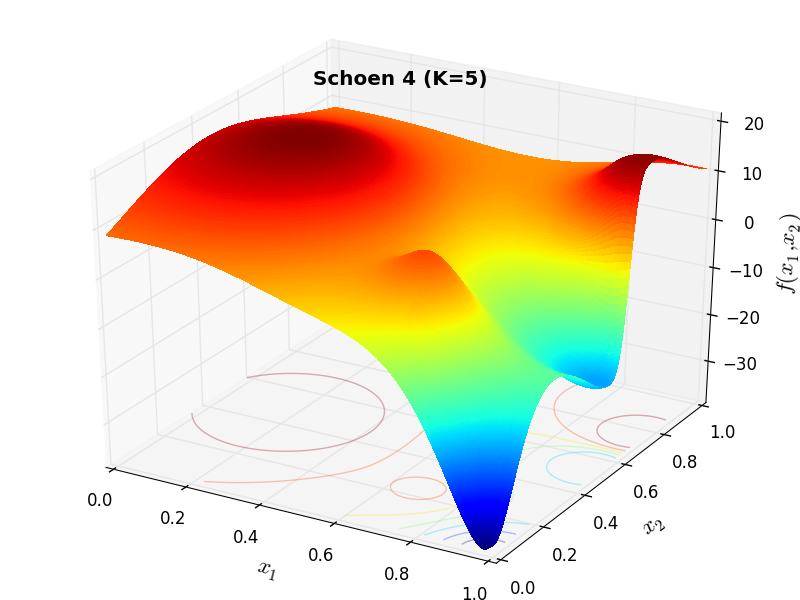
Schoen Function 4 |
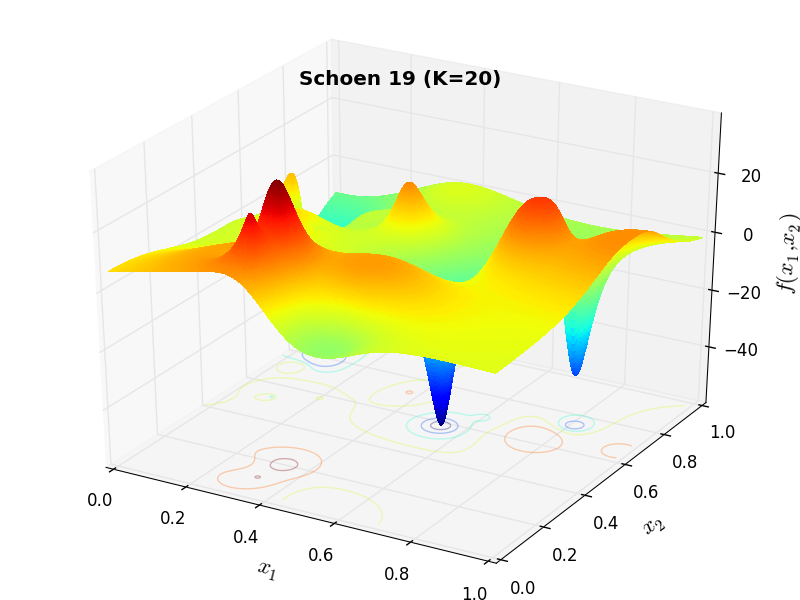
Schoen Function 19 |
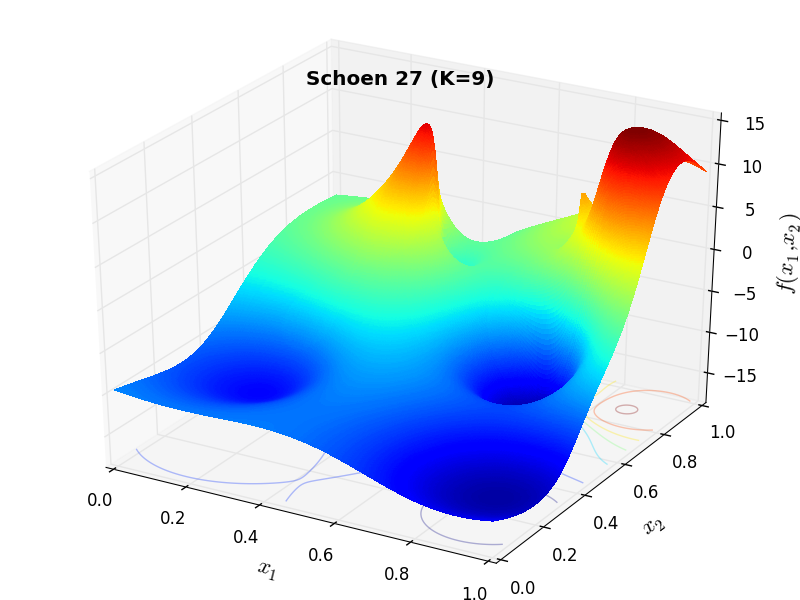
Schoen Function 27 |
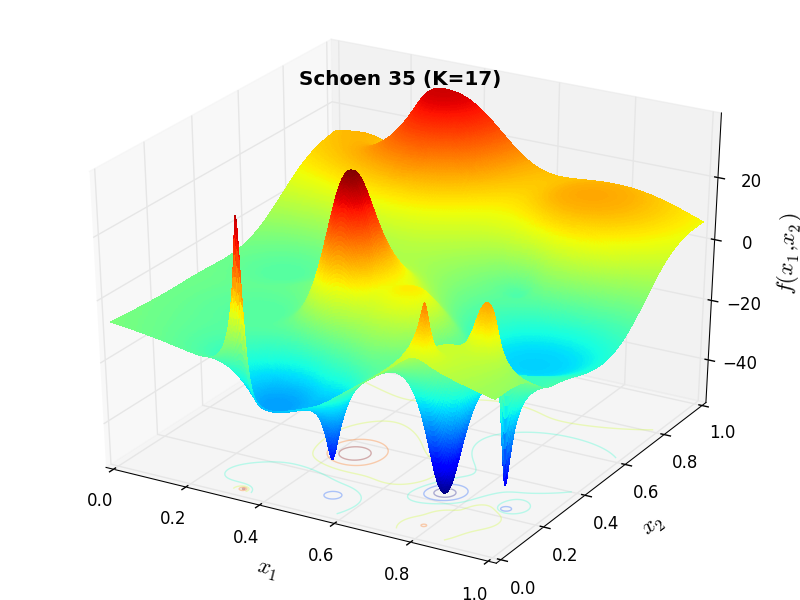
Schoen Function 35 |
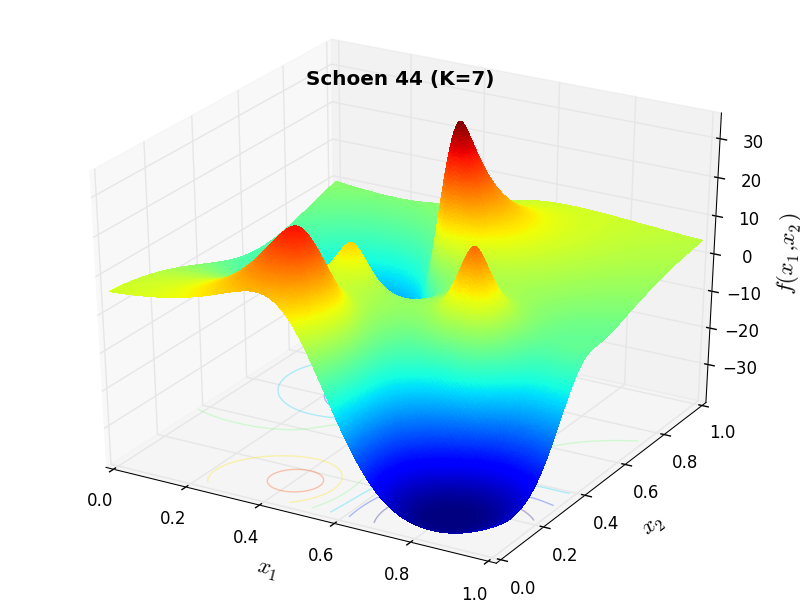
Schoen Function 44 |
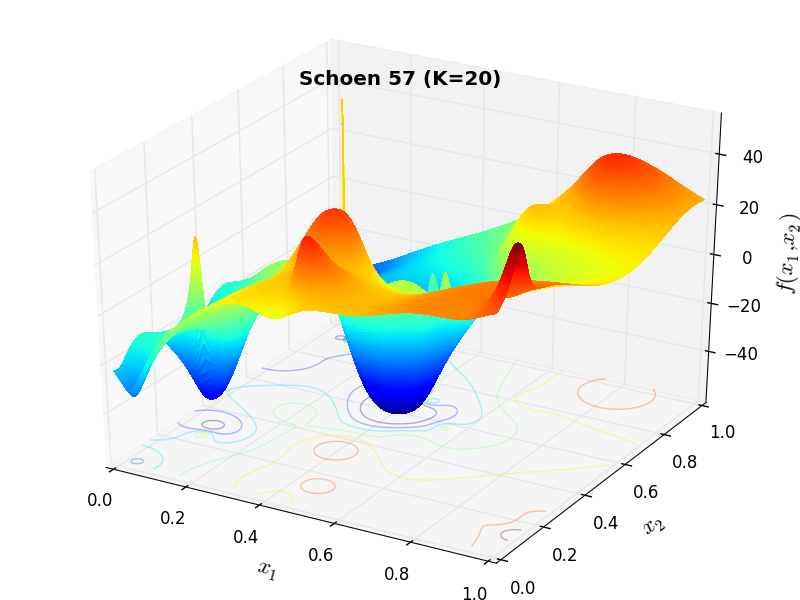
Schoen Function 57 |
 General Solvers Performances¶
General Solvers Performances¶Table 15.1 below shows the overall success of all Global Optimization algorithms, considering every benchmark function,
for a maximum allowable budget of  .
.
The Schoen benchmark suite is a very easy test suite: the best solver for  is SHGO, with a success
rate of 95.4%, but many solvers are able to find more than 75% of global minima: MCS, DIRECT, BasinHopping, and DualAnnealing.
is SHGO, with a success
rate of 95.4%, but many solvers are able to find more than 75% of global minima: MCS, DIRECT, BasinHopping, and DualAnnealing.
Note
The reported number of functions evaluations refers to successful optimizations only.
| Optimization Method | Overall Success (%) | Functions Evaluations |
|---|---|---|
| AMPGO | 53.33% | 278 |
| BasinHopping | 90.18% | 307 |
| BiteOpt | 70.53% | 286 |
| CMA-ES | 71.23% | 540 |
| CRS2 | 67.37% | 822 |
| DE | 52.28% | 1,393 |
| DIRECT | 75.44% | 313 |
| DualAnnealing | 85.61% | 159 |
| LeapFrog | 52.63% | 303 |
| MCS | 91.23% | 276 |
| PSWARM | 58.25% | 1,291 |
| SCE | 68.42% | 391 |
| SHGO | 95.44% | 267 |
These results are also depicted in Figure 15.2, which shows that SHGO is the better-performing optimization algorithm, followed by very many other solvers with similar performances.

Figure 15.2: Optimization algorithms performances on the Schoen test suite at 
Pushing the available budget to a very generous  , the results show MCS snatching the top spot from SHGO,
although the two algorithms are so close to be virtually equuivalent in performances. BasinHopping and AMPGO do also quite
well with more than 90% rate of success. The results are also shown visually in Figure 15.3.
, the results show MCS snatching the top spot from SHGO,
although the two algorithms are so close to be virtually equuivalent in performances. BasinHopping and AMPGO do also quite
well with more than 90% rate of success. The results are also shown visually in Figure 15.3.
| Optimization Method | Overall Success (%) | Functions Evaluations |
|---|---|---|
| AMPGO | 90.53% | 2,178 |
| BasinHopping | 95.09% | 498 |
| BiteOpt | 74.39% | 576 |
| CMA-ES | 78.95% | 871 |
| CRS2 | 69.82% | 904 |
| DE | 74.39% | 2,337 |
| DIRECT | 83.51% | 756 |
| DualAnnealing | 87.72% | 228 |
| LeapFrog | 52.63% | 303 |
| MCS | 96.84% | 485 |
| PSWARM | 71.93% | 1,571 |
| SCE | 69.47% | 437 |
| SHGO | 96.14% | 297 |
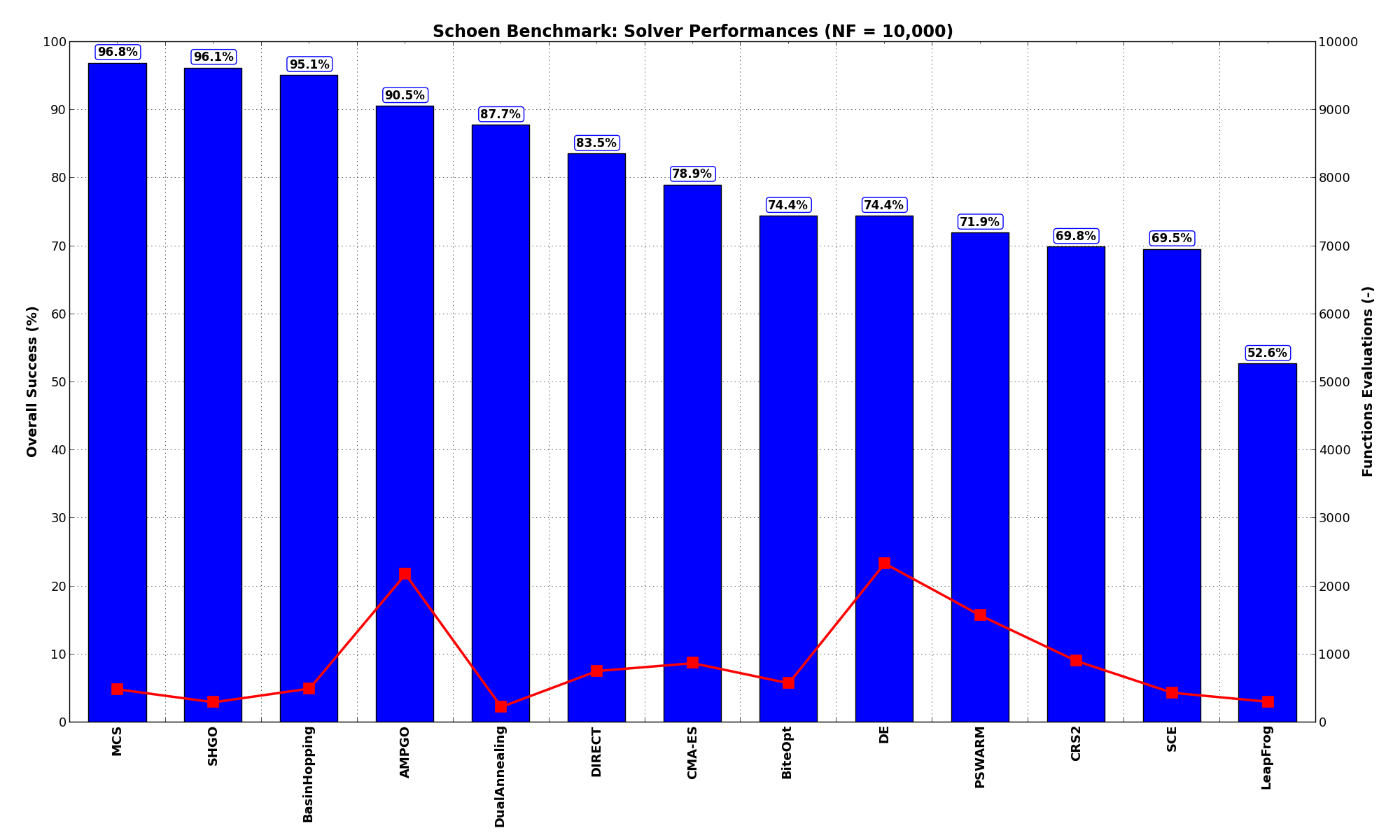
Figure 15.3: Optimization algorithms performances on the Schoen test suite at 
 Sensitivities on Functions Evaluations Budget¶
Sensitivities on Functions Evaluations Budget¶It is also interesting to analyze the success of an optimization algorithm based on the fraction (or percentage) of problems solved given a fixed number of allowed function evaluations, let’s say 100, 200, 300,... 2000, 5000, 10000.
In order to do that, we can present the results using two different types of visualizations. The first one is some sort of “small multiples” in which each solver gets an individual subplot showing the improvement in the number of solved problems as a function of the available number of function evaluations - on top of a background set of grey, semi-transparent lines showing all the other solvers performances.
This visual gives an indication of how good/bad is a solver compared to all the others as function of the budget available. Results are shown in Figure 15.4.
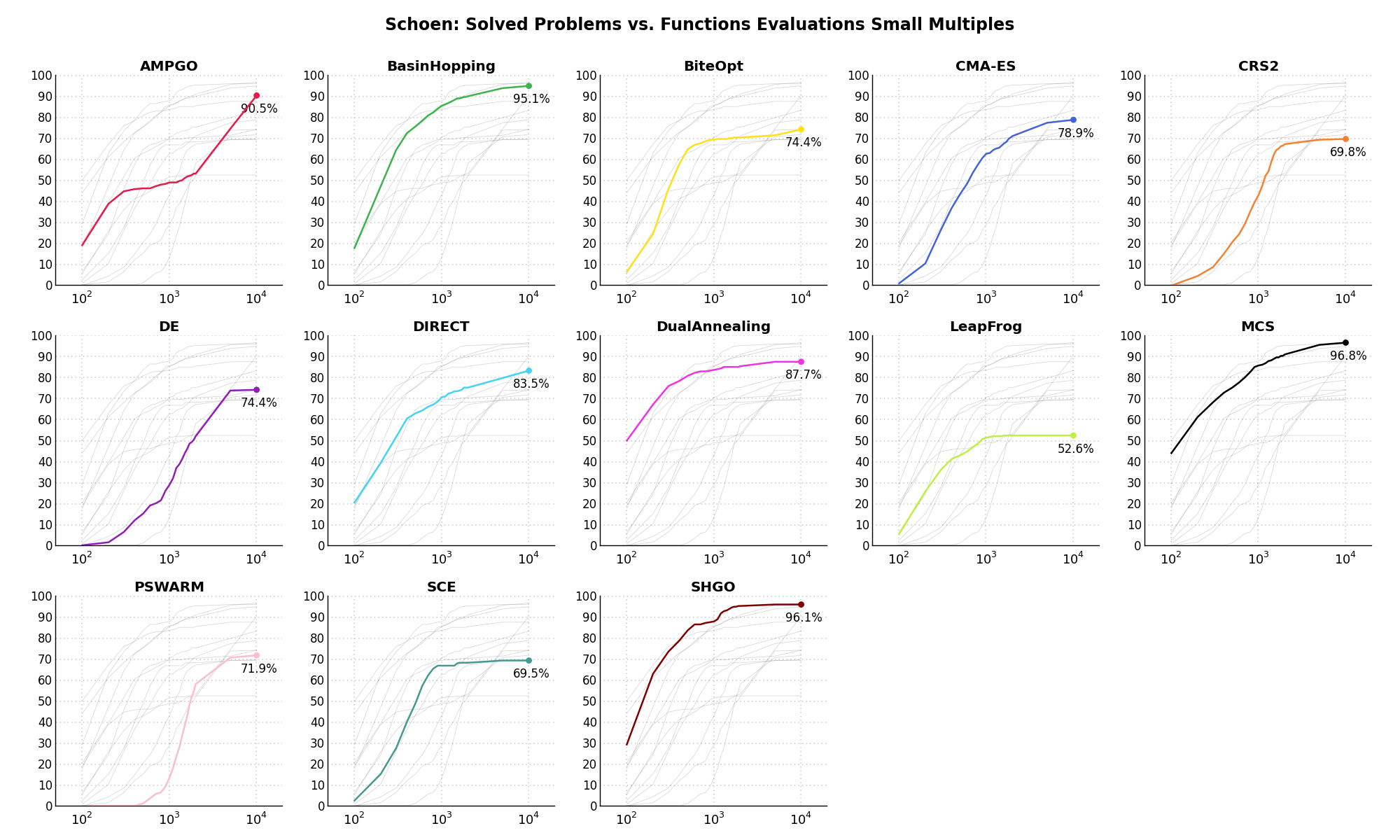
Figure 15.4: Percentage of problems solved given a fixed number of function evaluations on the Schoen test suite
The second type of visualization is sometimes referred as “Slopegraph” and there are many variants on the plot layout and appearance that we can implement. The version shown in Figure 15.5 aggregates all the solvers together, so it is easier to spot when a solver overtakes another or the overall performance of an algorithm while the available budget of function evaluations changes.
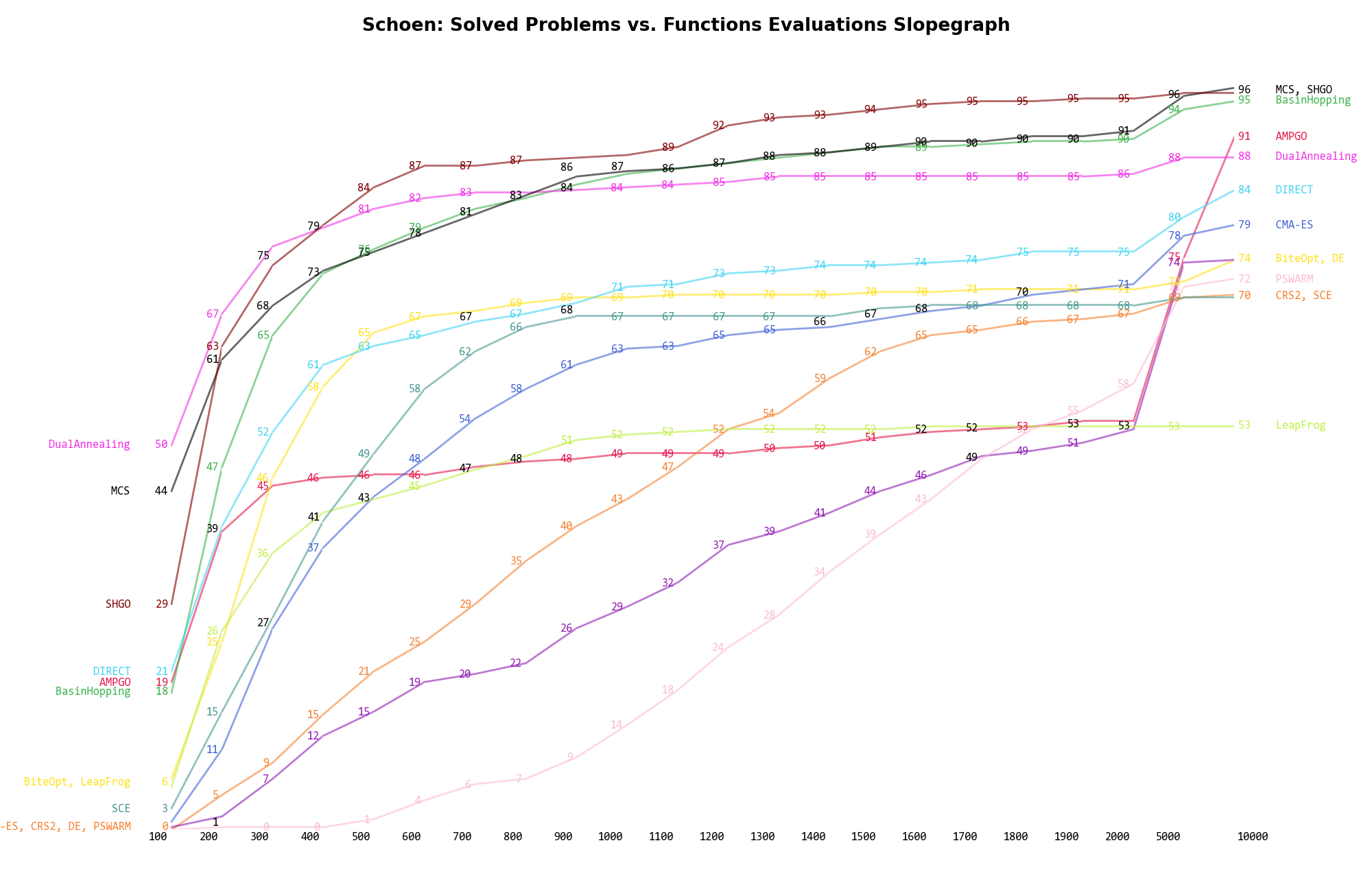
Figure 15.5: Percentage of problems solved given a fixed number of function evaluations on the Schoen test suite
A few obvious conclusions we can draw from these pictures are:
 ) DualAnnealing appears to be
the most successful solver.
) DualAnnealing appears to be
the most successful solver. Dimensionality Effects¶
Dimensionality Effects¶Since I used the Schoen test suite to generate test functions with dimensionality ranging from 2 to 6, it is interesting to take a look at the solvers performances as a function of the problem dimensionality. Of course, in general it is to be expected that for larger dimensions less problems are going to be solved - although it is not always necessarily so as it also depends on the function being generated. Results are shown in Table 15.3 .
| Solver | N = 2 | N = 3 | N = 4 | N = 5 | N = 6 | Overall |
|---|---|---|---|---|---|---|
| AMPGO | 61.4 | 52.6 | 57.9 | 47.4 | 47.4 | 53.3 |
| BasinHopping | 94.7 | 93.0 | 84.2 | 87.7 | 91.2 | 90.2 |
| BiteOpt | 78.9 | 68.4 | 66.7 | 71.9 | 66.7 | 70.5 |
| CMA-ES | 71.9 | 73.7 | 70.2 | 75.4 | 64.9 | 71.2 |
| CRS2 | 63.2 | 66.7 | 71.9 | 73.7 | 61.4 | 67.4 |
| DE | 77.2 | 73.7 | 68.4 | 42.1 | 0.0 | 52.3 |
| DIRECT | 94.7 | 84.2 | 77.2 | 63.2 | 57.9 | 75.4 |
| DualAnnealing | 91.2 | 82.5 | 82.5 | 89.5 | 82.5 | 85.6 |
| LeapFrog | 59.6 | 54.4 | 57.9 | 54.4 | 36.8 | 52.6 |
| MCS | 96.5 | 96.5 | 89.5 | 93.0 | 80.7 | 91.2 |
| PSWARM | 86.0 | 66.7 | 61.4 | 47.4 | 29.8 | 58.2 |
| SCE | 75.4 | 70.2 | 68.4 | 68.4 | 59.6 | 68.4 |
| SHGO | 100.0 | 100.0 | 94.7 | 94.7 | 87.7 | 95.4 |
Figure 15.6 shows the same results in a visual way.
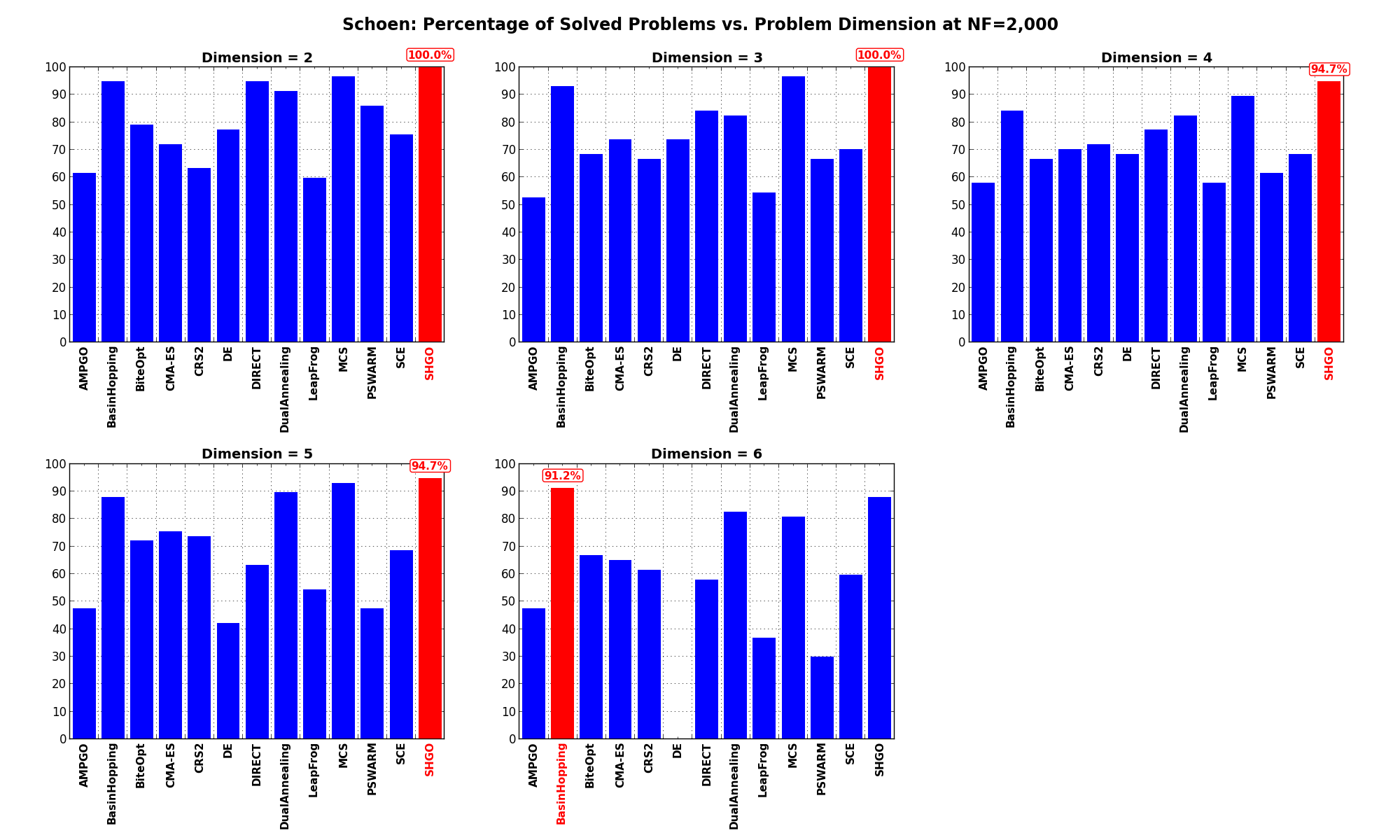
Figure 15.6: Percentage of problems solved as a function of problem dimension for the Schoen test suite at 
What we can infer from the table and the figure is that, for low dimensionality problems ( ), SHGO
has the perfect score of 100%, solving all problems, tightly followed by MCS, DualAnnealing and BasinHopping.
By increasing the dimensionality the trend doesn’t change much, although BasinHopping manages to take the load for
higher dimensions (
), SHGO
has the perfect score of 100%, solving all problems, tightly followed by MCS, DualAnnealing and BasinHopping.
By increasing the dimensionality the trend doesn’t change much, although BasinHopping manages to take the load for
higher dimensions ( ).
).
Pushing the available budget to a very generous  shows MCS taking the lead in general, although
SHGO and BasinHopping still behave astonishingly well.
shows MCS taking the lead in general, although
SHGO and BasinHopping still behave astonishingly well.
The results for the benchmarks at  are displayed in Table 15.4 and Figure 15.7.
are displayed in Table 15.4 and Figure 15.7.
| Solver | N = 2 | N = 3 | N = 4 | N = 5 | N = 6 | Overall |
|---|---|---|---|---|---|---|
| AMPGO | 93.0 | 96.5 | 91.2 | 91.2 | 80.7 | 90.5 |
| BasinHopping | 96.5 | 96.5 | 87.7 | 96.5 | 98.2 | 95.1 |
| BiteOpt | 84.2 | 75.4 | 71.9 | 73.7 | 66.7 | 74.4 |
| CMA-ES | 75.4 | 75.4 | 78.9 | 84.2 | 80.7 | 78.9 |
| CRS2 | 66.7 | 66.7 | 71.9 | 73.7 | 70.2 | 69.8 |
| DE | 77.2 | 73.7 | 71.9 | 78.9 | 70.2 | 74.4 |
| DIRECT | 96.5 | 91.2 | 80.7 | 80.7 | 68.4 | 83.5 |
| DualAnnealing | 93.0 | 89.5 | 82.5 | 89.5 | 84.2 | 87.7 |
| LeapFrog | 59.6 | 54.4 | 57.9 | 54.4 | 36.8 | 52.6 |
| MCS | 98.2 | 100.0 | 96.5 | 96.5 | 93.0 | 96.8 |
| PSWARM | 87.7 | 71.9 | 71.9 | 68.4 | 59.6 | 71.9 |
| SCE | 77.2 | 70.2 | 70.2 | 68.4 | 61.4 | 69.5 |
| SHGO | 100.0 | 100.0 | 94.7 | 98.2 | 87.7 | 96.1 |
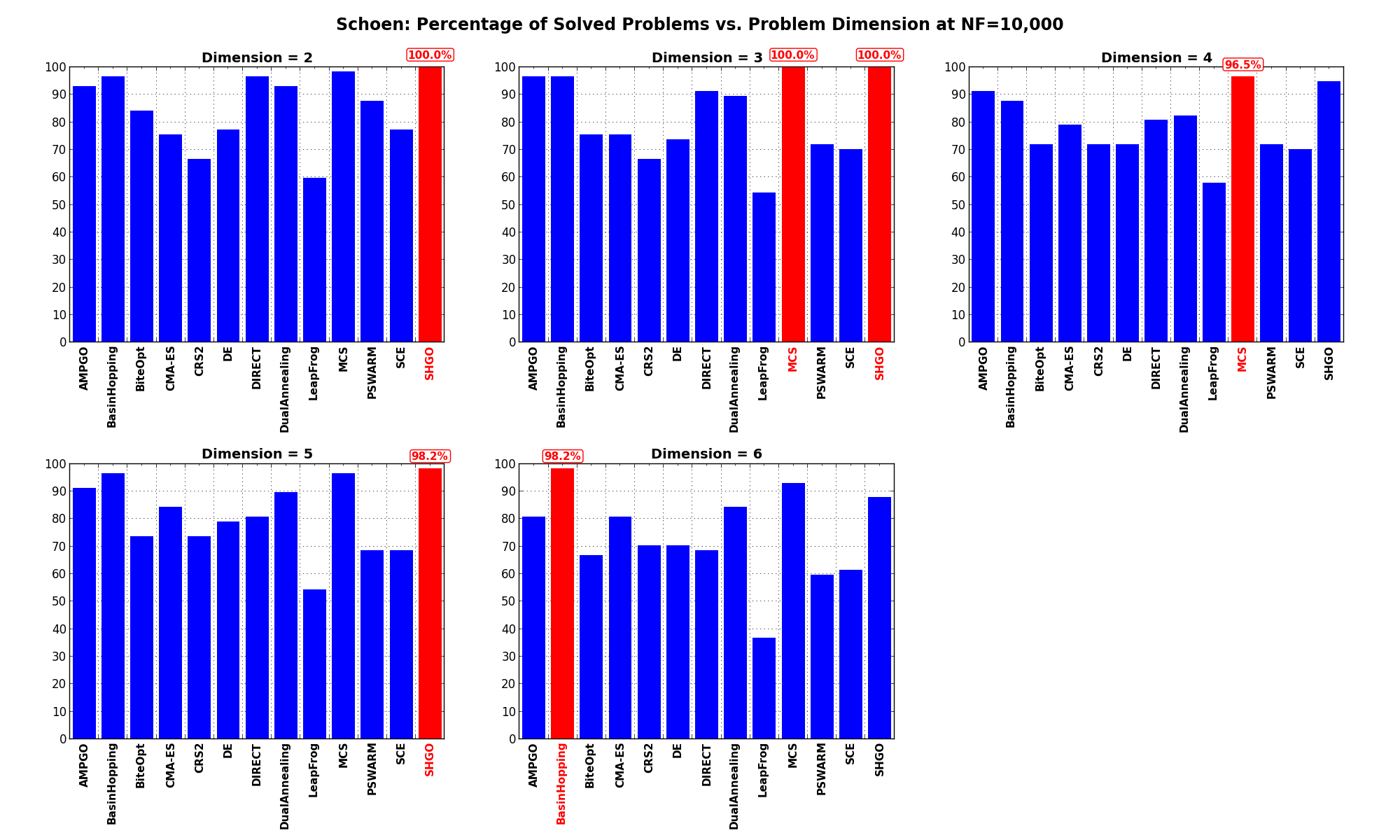
Figure 15.7: Percentage of problems solved as a function of problem dimension for the Schoen test suite at 